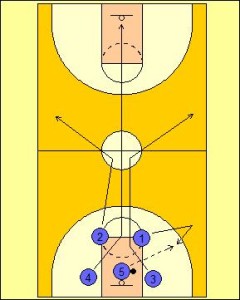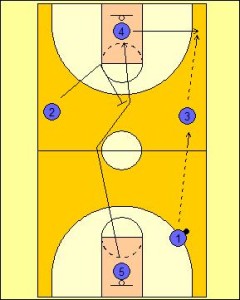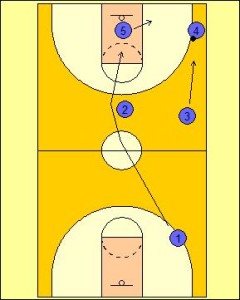Primary Transition: 1st Big Flare
A team’s Primary Transition helps use every second of a possession on the shot clock to its full potential as a scoring opportunity. The Primary Transition 1st Big Flare looks to provide a void in the middle of the keyway for breaking offensive players to move through and acquire good scoring options.
One of the significant benefits of the Primary Transition 1st Big Flare is that is relies heavily on players passing the ball to advance at every stage instead of dribbling. The passes within the sideline push of this primary transition are a minimum of ten feet in distance, but depending on the particular scenario, passes can range up to twenty feet as a norm.
The core offensive principle upon which the Primary Transition 1st Big Flare is built is to keep the keyway free of stationary players while in transition. Targets are still provided around the keyway and the front of the basket. However these players are moved on more quickly than traditionally planned and another player rotates into this position and then on again.
The Primary Transition 1st Big Flare is particularly useful for teams who have a smaller line-up featuring only one interior target.

The Primary Transition 1st Big Flare starts with a single player outlet (One). One (1) creates a lead away from the inbounder or rebounder before flashing back to the ball to receive the outlet pass.
The Four (4) who is the first big over halfway or a designated front of the basket lane runner sprints up the middle of the floor.
The Two (2) and Three (3) transition up the middle lane as well before flaring to the sidelines on their respective sides of the floor. The flare is encouraged so these players as passing targets still move down the floor stretching the defence evermore.
Scoring Option
- Four (4) on the direct pass from One (1)

Four (4) is not looking to post up so much as just provide an early scoring option so the defence again has to cover this player and therefore becomes stretched and in so doing opening passing or driving lanes. As Four (4) reaches the offensive end of the floor the player can present a stationary post target but this should only be for a count of one before moving out to the strong side long corner.
One (1) looks to push the ball as soon as possible down one side of the floor. Either Two (2) or three (3) can be a passing target. It is preferred if the ball is advanced down the same side of the floor because of ease in reading passing lanes and defender movements.
Three (3) in the scenario above looks to pass the ball onto Four (4) moving towards the sideline.
The weak side second receiver (Two) flashes to the basket. If their defender covers their cut then this player looks to set an up screen for the trailing big (Five).
Five (5) using the screen cuts to the basketball side of the screen.
Scoring Options
- Three (3) once receiving the pass must look to square up to the basket quickly. In some instances, their player will be above them and so a driving lane is open to the basket.
- Three (3) once making the pass should look to be constantly reading their defenders positioning and vision. If Three’s (3) defender breaks vision at any stage then Three (3) must attack the basket.
- Two (2) on the weak side cut to the basket
- Five (5) from the screen in the high post

Five (5) should look to hold a position at the front of the basket for a count of one before moving out to a strong side, mid-range position on the baseline.
Three (3) shortens the distance between the long corner by moving into the wing position.
At any time Four (4) can choose to pass the ball back to Three (3).
One (1) who should be the last player into the frontcourt and again uses Two (2) as a screen and cuts to the basket. As One (1) moves following the pass, the offensive player must attempt to bring their match-up across to the weak side of the split line. This will allow One (1) to cut over either side of the screen set by Two (2) as their defender will be moving along the split line.
Scoring Options
- Five (5) when stepping out to the mid-range position
- Pass from perimeter players (Four or Three) to One (1) when cutting to the basket.
- Another option when looking for One (1) as a scoring target, is to pass the ball into Five (5) draw the defender away from the basket for an easier pass to One (1) cutting to the basket.
The Primary Transition 1st Big Flare now finishes and team’s Secondary Transition or Half-court Offense phase takes over.


